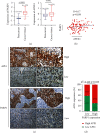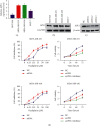Inhibition of APE1 Expression Enhances the Antitumor Activity of Olaparib in Triple-Negative Breast Cancer
- PMID: 35463096
- PMCID: PMC9020940
- DOI: 10.1155/2022/6048017
Inhibition of APE1 Expression Enhances the Antitumor Activity of Olaparib in Triple-Negative Breast Cancer
Abstract
Triple-negative breast cancer (TNBC) is a highly aggressive subtype of breast cancer that is prone to recurrence and metastasis. Because of the lack of expression of estrogen receptor (ER) and progesterone receptor (PR) and human epidermal growth factor receptor 2 (HER2) in TNBC, treatment methods are greatly limited. In this study, the proliferation inhibition and apoptosis-inducing effects of PARP1 inhibitors in TNBC breast cancer cells and in vivo xenograft animal models were examined to investigate the molecular role of APE1 in PARP1-targeted therapy. In TNBC patients, the expression of APE1 and PARP1 were positively correlated, and high expression of APE1 and PARP1 was associated with poor survival of TNBC. Our results indicated that knockdown APE1 could increase the sensitivity of olaparib in the treatment of TNBC. In conclusion, the results of this study will not only clarify the molecular role of APE1 in PARP1-targeted therapy for TNBC but also provide a theoretical basis for the future clinical application of targeting APE1 and PARP1 in the treatment of refractory TNBC.
Copyright © 2022 Dan Jian et al.
Conflict of interest statement
The authors declare that they have no conflicts of interest.
Figures







References
LinkOut - more resources
Full Text Sources
Research Materials
Miscellaneous

